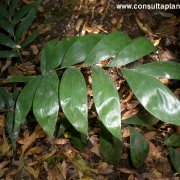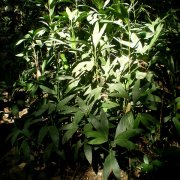Care of the indoor plant Chamaedorea elegans or Parlour palm |
|
The Chamaedorea genus, Arecaceae family, includes more than 200 species of palm trees native to tropical and subtropical regions of America. Some species are: Chamaedorea elegans, Chamaedorea carchensis, Chamaedorea arenbergiana, Chamaedorea oblongata, Chamaedorea stolonifera, Chamaedorea tepejilote. Common names: Neanthe bella palm, Parlour palm, Dwarf mountain palm. This species is native to Mexico and Guatemala. They are small palm trees of elegant bearing that reach 2 meters (6.56 feet) in height; they can produce suckers at the base. The decorative curved pinnate leaves (fronds) have leaflets up to 10 cm (3.93") in length. The flowers appear in clusters from the trunk, are shaped like yellow balls and are not decorative. These easy-to-grow plants that are used as indoor and greenhouse plants. In summer Parlour palm can be located outdoors avoiding direct sun. Chamaedorea elegans prefers a dim light exposure without direct sun; it also grows in the shade. The temperature should not be lower than 13 ºC (55.4 ºF). The soil must be rich in organic matter and have good drainage. The transplant is done when the roots appear below the pot. Water frequently in spring and summer with lime-free water so that the soil is always moist (never flooded); in winter water moderately. The ambient humidity must be medium-high; regularly spray the leaves with lime-free water. Fertilize in spring and summer every 15 days with mineral fertilizer. Dwarf mountain palm does not need pruning. Chamaedorea elegans does not normally suffer from serious pest and disease problems. Parlour palm is propagated by seeds sown in spring but it is a slow process. The propagation by separation of suckers is faster and easier. |
Images of the indoor plant Chamaedorea elegans or Parlour palm |
Find plants
Chamaedorea elegans or Parlour palm | Care and Growing
© 2025 FavThemes








